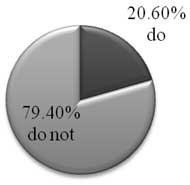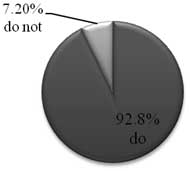First author Name: Erika Jane Dowling
Affiliation: Trinity College Dublin, Ireland
Second author name: Dr. Martine M Smith, PhD
Affiliation: Trinity College Dublin, Ireland
ABSTRACT
Purpose: This study investigates what adolescents consider important in determining whether a communication device is attractive and socially acceptable with peers. Features of the DynaVox V™, Tango™ and Pathfinder Plus™ were explored.
Method: A questionnaire addressing; appearance of communication devices; telecommunications; voice output, rate enhancement and vocabulary selection was used to investigate the attitudes of 97 adolescents without communication impairments. Data were analysed quantitatively using chi-square analysis, total & percentage scores and qualitatively using four themes.
Results: Overall, participants were willing to sacrifice appearance for communication efficiency. Features such as durability, portability, voice intelligibility and vocabulary to support social interaction were prioritised. Chi Square scores indicate that boys are significantly more likely to select a DynaVox V™.
Conclusion: Future communication devices should be reliable, capable of interconnectivity and support the development of social networks. As adolescents have unique preferences, opportunities must be provided to ensure involvement when selecting a device.
Keywords
Augmentative and Alternative Communication (AAC); communication device; adolescence; appearance, social participation.
BACKGROUND
Adolescence
During adolescence the approval of friends becomes critical [1]. Dissatisfaction with body image can become a key source of emotional turmoil [2], leading to feelings of self consciousness and a fear of being labelled ‘different’ [3]. The expression of personal and group identity becomes critical [4]. Adolescents crave acceptance and dread isolation, and social interaction is both the means for and the measure of such acceptance.
Adolescents spend a lot of time chatting, iteratively re-living past events with friends. Features of adolescent interaction include the use of slang [5], and a fast rate of communication [6]. Advancements in mainstream technology have also led to changes in adolescent interaction. Text messaging and email now play an important role in the maintenance of social networks [7, 8].
Adolescents With Complex Communication Needs
Adolescent AAC users experience the need for a positive self image and to participate in conversation [9]. Considering the pre-occupation with appearance at this age, the stigma of a disability can be difficult. Adolescents who feel self conscious may abandon their communication device as it looks ‘embarrassing’ [10], or due to a fear of being rejected by peers [11].
Peer acceptance is important for the development of social competence [12]. An AAC system is designed to supplement spoken communication, creating opportunities for participation [13]. However, negative attitudes may pose barriers to the inclusion of adolescents requiring AAC [14].
Augmentative and Alternative Communication
AAC is a ‘tool’ that supports communication and provides opportunities for social interaction [15]. However, some AAC users may reject their communication device due to inappropriate vocabulary, unreliability [16], if the device is not socially reinforcing or is rejected by peers [(17), (18)]. Therefore, there is a need to design a communication device that supports social participation, creates a positive self image and positive attitudes by peers.
Current Voice Output Communication Aids (VOCA’s)
If AAC systems are attractive, adolescent AAC users may be motivated to use their device, serving to enhance self esteem and facilitate interaction [19]. Current VOCA’s are products of great innovation, but are not without disadvantages [20]. They have limited aesthetic appeal. Complex device navigation strategies can decrease communication rate, while long pauses may result in a negative impression of the user’s communicative competence [9]. The absence of age appropriate vocabulary can distance the AAC user from peers. Poor voice intelligibility and naturalness can have negative implications for self expression [14]. A limited range of voice choices raises questions about the role of voice in reflecting the user’s communication identity [3].
Justification And Aims Of This Research Study
There is a paucity of information relating to the features of AAC technology that might be considered desirable by adolescents and thus influence selection. These issues prompted the research questions:
- What design features of AAC technology would typically developing adolescents identify as desirable? The reviewed devices are (a) DynaVox V™ (b) Tango™ (c) Pathfinder Plus™
- What aspects of adolescent daily life might influence the design of AAC technology?
- What design modifications might increase the appeal of future communication devices?
| Device | DynaVox V™ |
Tango™ |
Pathfinder Plus™ |
|---|---|---|---|
Manufacturer |
DynaVox Systems | Blink-twice | Prentke- Romich Co. |
Dedicated options |
Choice of both1 | Dedicated | Dedicated |
Display |
Dynamic | Fixed | Fixed |
Size |
23cm x 20 cm x 7cm | 4.5cm x 31.8 cm x 11.2 | 30.5 cm x 24.77 cm x 7.62 |
Weight |
4 lbs 11oz | 2.5 lbs | 2.02kg |
Selection method |
Direct selection, auditory scanning, joystick, Morse code, | Direct selection and scanning method | Direct selection via keyboard and switch activated scanning |
Design |
Choice of 5 colours, square shape with two front mounted speakers. Touch screen | White/ grey with green buttons, cylinder shape, touch screen and 6 control buttons | Blue/ Grey square shape with 128 static keys; each button has a symbol with a word/ phrase stored. |
Voice output |
Synthesised & digitised option inc. DECtalk and AT & T natural voices |
Digitised, Synthesised & voice morphing (expression and prosody) | Synthesised -choice of ten voices RealSpeak™ natural voice |
Telecommunication features 2 |
A Bluetooth adaptor to send/ receive texts | Compact flash expansion slot – for future use of mobile & Bluetooth | Air card – enables device to operate as cell phone (send/ receive call/ texts) |
Entertainment features |
calculator, address book, MP3 player, games | Digital camera | calculator, play MP3 files, notebook journal |
Rate enhancement features |
Word, character and phrase prediction Slots3 , Quickfires4 |
Phrase bank and pop up keyboard to allow for efficient communication | Spelling, word prediction and icon prediction |
Vocabulary |
InterAACT | Language streams; quick access to topics and relevant vocabulary | Semantic compaction (Unity 32/128); meaning is assigned to graphical icons |
| 1 The DynaVox V™ also comes in an open format where it operates as a fully functioning XP computer 2 all devices provide computer connectivity allowing for internet activity – this requires the use of wires/ cables or in the case of the Pathfinder Plus™ infrared is available. 3 Slots – provide easy access to related words that can be used to complete a message 4 quickfires – short conversational interjections that are available on the main page |
|||
METHODOLOGY
Research Design
This is a non experimental questionnaire - based study. The questionnaire consisted of 29 items and focused on three themes: (a) physical appearance (b) functions and features (c) components related to communication. The Communication Aid Protocol [21] served as a guide for developing the questionnaire, and themes are based on those described by Light [22]. To ensure face validity, Senior Speech and Language Therapists reviewed the questionnaire and agreed the items were applicable to the project. A preliminary form of the questionnaire was field tested and subsequently modified for use in the study. Modifications included changes to the structure and changes to five questions.
Table 2.1; This tables provides examples of the items contained in the questionnaire used in this research study
Section |
Sample Question |
||||||||||||||||||||||||||||||||||||||||||||||||||||||||||||||||||||||||||||||||||||||||||||||||||||||||||||||||||||||||||||||||||||||||||||||||||
|---|---|---|---|---|---|---|---|---|---|---|---|---|---|---|---|---|---|---|---|---|---|---|---|---|---|---|---|---|---|---|---|---|---|---|---|---|---|---|---|---|---|---|---|---|---|---|---|---|---|---|---|---|---|---|---|---|---|---|---|---|---|---|---|---|---|---|---|---|---|---|---|---|---|---|---|---|---|---|---|---|---|---|---|---|---|---|---|---|---|---|---|---|---|---|---|---|---|---|---|---|---|---|---|---|---|---|---|---|---|---|---|---|---|---|---|---|---|---|---|---|---|---|---|---|---|---|---|---|---|---|---|---|---|---|---|---|---|---|---|---|---|---|---|---|---|---|---|
A - Physical appearance of the communication device |
|
||||||||||||||||||||||||||||||||||||||||||||||||||||||||||||||||||||||||||||||||||||||||||||||||||||||||||||||||||||||||||||||||||||||||||||||||||
B – Functions and Features of Communication Devices |
|
||||||||||||||||||||||||||||||||||||||||||||||||||||||||||||||||||||||||||||||||||||||||||||||||||||||||||||||||||||||||||||||||||||||||||||||||||
C – Parts of the communication device related to communication |
How communication devices sound (voice output)
Rate enhancement features:
Vocabulary Selection
|
Participants
Ninety-seven typically developing adolescents participated in this study, and completed the questionnaire outlined above. Inclusion criteria for participants were; (a) between the ages of 15 years and 16:11 years; (b) fluent in English; (c) attending mainstream secondary school.
Gender |
Age |
Number of participants |
|---|---|---|
Boys (n =52) |
15 years |
34 |
Girls (n=45) |
15 years |
32 |
Procedures
Ethical Approval for the project was given by Trinity College Dublin. A PowerPointpresentation about the field of AAC and purpose of the study was created. A loan of the communication devices was not possible; to compensate a DVD of each device in operation was made. This was based on a video demonstration of the Tango™. The same sentences were programmed into each device to ensure consistency and eliminate bias. Data collection took place in the participant’s school over a one hour period. First The PowerPoint presentation was shown and then the DVD. Participants then completed the questionnaire
Data Analysis
The coding system used to develop the questionnaire was used to qualitatively describe findings. The data was sorted into the themes of ‘the 21st century adolescent’, ‘physical appearance’, ‘functions’ and ‘components of the communication device’. Data was summarised for the 4 coding themes and 8 subthemes.
| Themes | subthemes | Examples |
|---|---|---|
The Modern Adolescent |
|
|
Physical appearance (Attributes of the external device) |
Communication device features |
|
Self image and psychosocial issues |
|
|
Functions (purpose and uses of the communication device) |
Telecommunications
Play and entertainment features |
|
Adolescent life |
|
|
Section C; |
Voice output |
|
Rate enhancement features |
|
|
Vocabulary selection |
|
Quantitative analysis methods (Chi-Square analysis, and total and percentage rating scores) were used to compare and contrast preferences across gender, and to rank features according to level of importance.
RESULTS
The Modern Adolescent
Over 70% of participants spend time talking with ‘my best friends’, primarily in school. Adolescents talk about a variety of things; personal information, family and friends were considered most important. Texting, internet access and listening to music were identified as important features of adolescent life.
| Who would they talk to? | Where and when would they talk? | What topics would they talk about? | Are interested in doing what? | |
1. |
My best friend | School | Family | All kinds of sports |
|---|---|---|---|---|
2. |
My mum | At home | Personal information | Watching television |
3. |
My brothers and sisters | Going out | Things I need help with | Listening to music |
4. |
My dad | At sports training | My friends | Talking/texting friends |
5. |
My boyfriend/ girlfriend | At friends house | What they like to eat and drink | Hanging out with friends |
External Appearance of Communication Devices
Participants identified reliability and portability as most important, while colours and use of skins were not considered important. Over 96% of participants (% rating score) stated the design of a communication device should not embarrass the AAC user.
| Overall ranking (determined by total number of points) | Ranking as determined by percentage rating (number of students selecting important, very and critically important) | ||
|---|---|---|---|
1. durability and reliability (won’t break easily) |
351/ 388 |
1. light and portable |
98.9% |
2. light and portable |
331 |
2. durability and reliability (won’t break easily) |
97.9% |
3. weight (not too heavy) |
323 |
3. size (not too big) |
97% |
4. size (not too big) |
298 |
4. weight (not too heavy) |
94% |
5. materials (comfortable to carry and touch) |
284 |
5. materials (comfortable to carry and touch) |
91.7% |
6. themes – reflects what I like |
244 |
6. themes – reflects what I like |
80.4% |
7. look cool to others |
241 |
7. interesting shape (not just a box) |
78.3% |
8. interesting shape (not just a box) |
218 |
7. look cool to others |
78.3% |
9. choice of different skins |
211 |
8. choice of different skins |
70% |
10. colours (can be different colours) |
172 |
9. colours (can be different colours) |
57.5% |
Recommended changes and modifications to communication devices included the use of a touch screen and a reduction in size.
| Overall ranking (determined by total number of points) | Ranking as determined by percentage rating (number of students selecting important, very and critically important) | ||
|---|---|---|---|
1.communication device should have a touch screen |
303/388 |
1. communication device should have a touch screen |
93.8% |
2. reduce size of communication device |
287 |
2. reduce size of communication device |
90% |
3. communication device should have less buttons |
255 |
3. communication device should have less buttons |
84.5% |
4. communication device should look more like a mobile phone |
252 |
4. communication devices should be different shapes |
78.3% |
5. communication devices should be different shapes |
222 |
5. use gender specific features in the design of communication devices |
73.1% |
6. use gender specific features in the design of communication devices |
210 |
6. communication devices should have a choice of more colours |
65.9% |
7. use of skins to change the appearance of communication devices |
189 |
7. use of skins to change the appearance of communication devices |
63.9% |
8. communication devices should have a choice of more colours |
184 |
8. communication devices should look more like a mobile phone |
60.8% |
9. communication device has pictures on the outside |
136 |
9. communication device has pictures on the outside |
39.1% |
10. communication devices should have more buttons |
81 |
10. communication devices should have more buttons |
18.5% |
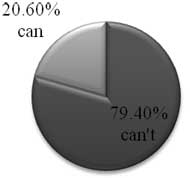
Chart 3.1 % of participants who can/can’t imagine life without access to phone etc (Click for larger view)
Participants prioritised practical features over aesthetics. 82.5% considered memory capacity for communication more important than appearance. However, over 86% stated that further thought should be given to the aesthetic appeal of AAC technology.
The DynaVox V™ was identified as the most popular communication device, participants liked its colour and flat screen. Over 60% selected it as the most attractive, and the device they would feel most comfortable using in public. Chi square analysis revealed a significant gender effect. Boys showed a significant preference for the DynaVox V™. Boys selected the DynaVox V™ as the most attractive communication device (p = 5.96, at p<0.5) and the device they would feel most comfortable using at the cinema (p = 7.57, at p<0.1).
The Tango™ was second favourite due to its small size and interesting shape. The Pathfinder Plus™ was the least popular communication device, 98.97% of participants selected it as the least attractive due to its bulky appearance and large number of selection keys.
|
DynaVox V (N) |
Tango |
Pathfinder Plus |
Most attractive communication device |
62 |
35 |
0 |
Least attractive communication device |
1 |
0 |
96 |
Device you would feel most comfortable using at the cinema |
60 |
36 |
1 |
Device which best reflects technology |
59 |
38 |
0 |
Functions (Purpose And Use Of The Communication Device)
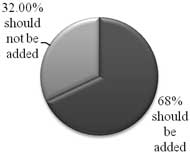
Chart 3.4 % of participants that think features that should be integrated into communication devices (Click for larger view)
Results emphasise the importance of distance communication, more than 90% of participant’s text every day. The integration of text messaging, email and music were of paramount importance. For some participants communicative function was more important than telecommunications, and should only be integrated ‘if not going to take away from communication potential’.
Overall ranking (determined by total number of points) |
Ranking as determined by percentage rating (number of students selecting important, very and critically important) |
||
1. the ability to text friends and family |
316/388 |
1. ability to text friends and family |
97% |
2. ability to phone friends and family |
261 |
2. ability to listen to, and download music |
84.5% |
3. ability to listen to, and download music |
255 |
3. ability to phone friends and family |
80% |
4. ability to access the internet |
243 |
4. ability to access the internet |
78.3% |
5. ability to browse the web (e.g. connect to Bebo™) |
241 |
5. ability to browse the web (e.g. connect to Bebo™) |
77.3% |
6. ability to email friends and family |
239 |
6. ability to email friends and family |
76.2% |
7. communication device has Bluetooth |
202 |
7. communication device has Bluetooth |
64.9% |
8. ability to take pictures with a built in digital camera |
193 |
8. ability to take pictures with a built in digital camera |
59.7% |
9. games to entertain you |
163 |
9. games to entertain you |
56.7% |
10. ability to take video recordings |
161 |
10. ability to take video recordings |
51.5% |
Components Of The Device Related To Communication
Adolescents expressed the need for a voice that is not only intelligible, but that also sounds natural with qualities reflecting characteristics of the user e.g. gender.
Overall ranking (determined by total number of points) |
Ranking as determined by percentage rating (number of students selecting important, very and critically important) |
||
|---|---|---|---|
| 1. voice is clear and easily understood | 384/388 | 1. voice is clear and easily understood | 100% |
| 2. voice is natural sounding | 351 | 2. voice is natural sounding 2. voice is similar speed/ rate to natural speaker |
98.9% 98.9% |
| 3. voice is similar speed/ rate to natural speaker | 346 | 3. voice does not sound computerised 3. you can be heard in noisy situations |
97.9%97.9% |
| 4. voice does not sound computerised 4. You can be heard in noisy situations |
340340 | 4. voice is the same gender as you 4. you can change the voice to reflect how you feel 4. voice is the same nationality/ accent as you |
92.7%92.7% 92.7% |
| 5. voice is the same gender as you | 329 | 5. you can change the voice to whisper and shout | 89.6% |
| 6. voice is the same nationality/ accent as you | 301 | 6. voice sounds similar to peers | 87.6% |
| 7. you can change the voice to reflect how you are feeling | 300 | ||
| 8. you can change the voice to whisper and shout | 286 | ||
| 9. voice sounds similar to peers | 262 | ||
Participants felt that communication rate should not hinder social interaction with peers. Almost 58% of participants stated they would react to slow rate of communication by abandoning the communication device.
Overall ranking (determined by total number of points) |
Ranking as determined by percentage rating (number of students selecting important, very and critically important) |
||
1. the rate of communication does not stop me from talking with friends |
338/388 |
1. the rate of communication does not stop me talking with friends |
97.9% |
2. I am not embarrassed by the slow rate of communication |
324 |
2. rate of communication is similar to typical communication |
95.8% |
3. important that people do not think I am unintelligent because of the slow rate of communication |
313 |
3. I am not embarrassed by the slow rate of communication |
93.8% 93.8% |
4. rate of communication is similar to typical communication |
304 |
4. important that people do not think I am unintelligent because of the slow rate of communication |
91.7% |
5. communication device has features to speed up the rate of communication |
296 |
5. communication device can predict what you are typing |
89.6% 89.6% |
6. communication device can predict what you are typing |
285 |
6. communication device has spell check features |
87.6% |
7. communication device has spell check features |
275 |
|
|
8. communication device has word morphology features |
274 |
|
|
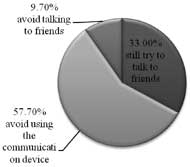
Figure 3.5: This figure presents participants reaction (in terms of percentages) to slow rate of communication (Click for larger view)
Adolescents prioritised the programming of vocabulary to express basic human needs More than 96% of participants prioritised vocabulary to support social relationships over academic learning. Two thirds of participants would want these words to be selected by a friend, with only 8.2% wanting input from a professional speech and language therapist.
| Basic needs | Social phrases |
Verbs |
Feelings/ emotions |
Commands |
Other |
|---|---|---|---|---|---|
| Toilet | Hi / hello | Sleep | Tired/ sleepy | Stop | Feck |
| food | Bye | Play | Hungary | Piss off | Curse words |
| drink | Please | wash | Thirsty | Shut up | Fuck |
| Thanks | Lonely | Leave me alone | Injury | ||
| People | Yes | Questions | Pain | I need | Itch |
| Family | No | What | Bored | Come here | So it is |
| Friends | Ok | Why? | Happy | Go away | I’ll see |
| parents | Adios | How? | Love you | Ha ha | |
| Going out, back at ten | Can I? | Sad | Hobbies | ||
| Places | Oh no | How come? | Sick/ Ill | Music | |
| Bedroom | Cold | Television | |||
| Bathroom | Too warm/ hot | Texting | |||
| Home | movies |
DISCUSSION
Effect Of Device Type
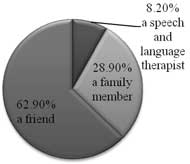
Figure 3.6; This figure presents the percentage of participants who choose different people to select vocabulary for communication device (Click for larger view)
Adolescents rated the DynaVox V™ and Tango™ as most popular. Their design does not look conspicuous and may be easily integrated into adolescent life, thus reducing self consciousness. The sophisticated design and choice of colours of the DynaVox V™ was favoured, reflecting the choice adolescents have when selecting an i-POD. The Tango™ was favoured for its small size, indicating adolescents require a device they can carry and use in all environments. Keys and buttons were considered undesirable, contributing to the unpopularity of the Pathfinder Plus™. As Semantic Compaction is a feature of the Pathfinder Plus™, the static keyboard is essential for effective communication. Attitudes may be less negative if participants were given the opportunity to operate the device. When selecting a communication device for adolescents, the use of learning trials to demonstrate the communication potential of the Pathfinder Plus™ may help to ensure that it is not disregarded due to its appearance.
The unique preferences demonstrated by participants emphasises the importance of ensuring adolescents participate in the selection of a communication device. Similar procedures described by Sigafoos et al [23] could be adopted to ensure active involvement of adolescents during the selection process.
Influence Of Adolescent Life On The Design Of AAC Technology
Adolescents, who are described as being pre-occupied with body image [6], were prepared to sacrifice cosmetic appeal for communication efficiency. Memory capacity for communication was considered more important than appearance. As participants communicate in a variety of environments, characteristics such as portability and size were of prime interest.
Adolescents identified ‘best friends’ as their main social network, where they chat about life experiences. Communication devices must then allow AAC users to share personal narratives with peers [3]. As most participants would want swear words programmed on a communication device, AAC users should then have access to age appropriate vocabulary, to promote group inclusion [3]. Unfortunately, inclusion and acceptance can be compromised by negative societal attitudes. Participants stated that “friends might not like you anymore and think you’re stupid” and “people would recognise you as the person with the huge device and bullying would be a problem”. These findings highlight the need to challenge negative societal attitudes towards AAC users.
Suggestions For The Design Of Future AAC Technology
Although individual differences are to be expected among adolescents, table 4.1 provides a summary of the recommendations that may be considered in the design of future communication devices. However, advances in technology will be of little use unless barriers to participation are overcome and strategies to support participation are implemented.
| Type of Feature | Design Suggestion |
Physical appearance and Design Characteristics |
|
Interconnectivity and Tele-communications |
|
Features related to communication |
|
Limitations Of The Current Investigation And Future Research
- Participants were from a single school and represented a narrow socio-economic group. Results can be only generalised to similar individuals. Identifying the priorities of people who use AAC should be the focus of future research.
- This research could be replicated with different communication devices to determine if similar findings would be achieved.
- Studies [(2), (6)] suggest there is a greater emphasis on physical appearance during the ages of 10-16years. Replicating this study with younger adolescents would determine if more importance would be place on appearance.
- Research must focus on identifying factors that promote the development of social networks for adolescents that use AAC. For example, “The Social Networks Model” [24] considers AAC within the context of the individual, family and peers.
Conclusion
Investigating the preferences of adolescents provides valuable insights into how the design of future devices may be improved. Future AAC technology should be reliable, robust, capable of interconnectivity and support the development of social networks. As independence is important for adolescents, opportunities must be provided to ensure they are involved in selecting their device.REFERENCES
- Fortman, J. (2003). Adolescent language and communication from an intergroup perspective. Journal of Language and Social Psychology. 22 (1), 104-111
- Hartzell, H.E. (1984). The challenge of adolescence. Topics In Language Disorders. 4 (2), 1-9.
- Smith, M.M. (2005). The Dual Challenges of Aided Communication and Adolescence. Augmentative and Alternative Communication. 21 (1), 67-79.
- Erikson, 1950 in Bee, H & Boyd, D (2004). The Developing Child: International Edition.10th Ed. US: Allyn and Bacon Pearson Education
- Nipplod (1985) cited in, Smith, M.M. (2005). The Dual Challenges of Aided Communication and Adolescence. Augmentative and Alternative Communication. 21 (1), 67-79.
- Turkstra, L.S. (2000a). Should my shirt be tucked in or left out? The Communication Context of adolescence. Aphasiology. 14 (4), 349-364.
- von Tetzchner, S., & Martinsen, H. (1992). Introduction to symbolic and augmentative communication. London: Whurr Publishers
- McNaughton, D. & Bryen, D.N. (2007). AAC Technologies to Enhance Participation and Access to meaningful Societal Roles for Adolescents and Adults with Developmental Disabilities who require AAC. Augmentative and Alternative Communication. 23 (3), 217-229.
- Hoag, L.A., Bedrosian, J.L., Johnson, D.E., Molineux, B. (1994). Variables Affecting Perceptions of Social Aspects of the Communicative Competence of an Adult AAC user. Augmentative and Alternative Communication. 10, 129-137.
- Clarke (2001) cited in, McNaughton, D., Rackensperger, T., Benedek-Wood, E., Krezman, C., Williams, M.B., Light, J. (2008). "A child needs to be given a chance to succeed": Parents of Individuals who use AAC Describe the Benefits and Challenges of Learning AAC Technologies. Augmentative and Alternative Communication. 24 (1), 43-55.
- Turkstra, L., Ciccia, A., Seaton, C. (2003). Interactive Behaviours in Adolescent Conversation Dyads. Language, Speech and Hearing Services in Schools. 34, 117-127.
- Armita et al, 1998 cited in, Lilienfeld, M. & Alant, E. (2005). The social interaction of an adolescent who uses AAC: The evaluation of a peer training programme. Augmentative and Alternative Communication. 21 (4) 278-294.
- Wilkinson, K.M., & Hennig, S. (2007). The State of Research and Practice in Augmentative and Alternative Communication for Children with Developmental/ Intellectual Disabilities. Mental Retardation and Developmental Disabilities Research Reviews. 13, 58-69.
- Lilienfeld, M., Alant, E. (2002). Attitudes of Children Toward an Unfamiliar Peer Using an AAC Device With and Without Voice Output. Augmentative and Alternative Communication. 18 (2), 91-101.
- Light, J. (1997). "Communication is the Essence of Human Life": Reflections on Communicative Competence. Augmentative and Alternative Communication. 13 (2), 61-70.
- Smith, M.M., Connolly, I. (2008). Roles of aided communication. Perspectives of adults who use AAC. Journal of Disability and Rehabilitation; Assistive Technology. 3 (5), 260-273.
- Rackensperger, T., Krezman, C., McNaughton, D., Williams, M.B., D'Silva, K. (2005). "When I First Got It, I Wanted To Throw It Off A Cliff": The Challenges and Benefits of Learning AAC Technologies as Described by Adults who use AAC. Augmentative and Alternative Communication. 21 (3), 165-186.
- Angelo, D.H., Kokoska, S.M., Jones, S.D. (1996). Family perspectives on augmentative and alternative communication: families of adolescents and young adults. Augmentative and Alternative Communication. 12 (1), 13-22.
- Light, J., Drager, K., Nemser, J.G. (2004). Enhancing the Appeal of AAC Technologies for Young Children: Lessons from Toy Manufacturers. Augmentative and Alternative Communication. 20 (3), 137-149.
- Smith, J. (2006). This way of life: top ten “most wanted” AAC features. Retrieved September 9th 2008 from http://www.thiswayoflife.com/toptenaac.html
- O’Keeffe, B.M., Brown, L., Schuller, R. (1998). Identification and rankings of
communication aid features by five groups. Augmentative and Alternative Communication. 14 (1), 37-50.
- Light, J., Page, R., Curran, J., Pitkin, L. (2007). Children's Ideas for the Design of AAC Assistive Technologies for Young Children with Complex Communication Needs. Augmentative and Alternative Communication. 23 (1), 1-14.
- Sigafoos, J., O'Reilly, M., Ganz, J.B., Lancioni, G.E., Schlosser, R.W. (2005). Supporting self-determination in AAC interventions by assessing preference for communication devices. Journal of Technology and Disability. 17 (3), 143-153
- Blackstone, S.W. & Hunt Berg, M. (2003). Social Networks: A communication inventory for individuals with complex communication needs and their partners. Monterey, CA; Augmentative Communication, Inc.
Contact author
Erika Jane Dowling, Clinical Speech & Language Studies, 184 Pearse Street, Trinity College, Dublin 2, Ireland.
Phone: +353 87 9587174
Email: edowling@tcd.ie
